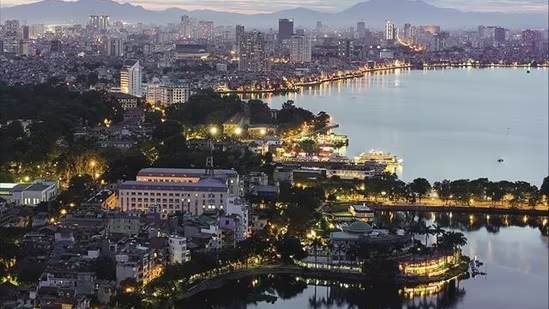South-East Asia’s tourism industry is hobbled by uncertainty
A THAI BEACH in high season is normally a carnival of umbrellas and selfie sticks, drained coconuts and peeling skin. But this year Koh Samui, an island popular with foreign tourists, “is like a graveyard”, says Virach Pongchababnapa, a local hotelier. Tourists are gone. Hotels and restaurants are boarded up. “There is no life, no movement,” Mr Virach sighs.  PREMIUM
PREMIUM
This was supposed to be the year that South-East Asia’s tourism industry—on life-support since the pandemic struck—began to recover. The Omicron variant, however, delayed the revival. At the end of 2021, several countries began admitting tourists for the first time in nearly two years, only to slam the door shut again when Omicron emerged.
This month borders started creaking open once more, some wider than others. Fully jabbed travellers no longer need quarantine in Thailand as of February 1st, or the Philippines, starting February 10th. Thailand is expecting 300,000 visitors this month—a far cry from the pre-pandemic monthly average of 3m, but a start.
Government bean counters will be pleased. South-East Asia’s economy relies on tourism more than any other region in the world bar the Caribbean, according to the World Trade and Tourism Council, an industry body. In 2019, the last year that people could travel freely, tourism contributed nearly 12% of the region’s GDP. The industry accounted for about a seventh of Cambodia’s economy and employed a fifth of Thailand’s workforce.
People from outside the region are the lifeblood of the business. They spend half of all tourist dollars even though, in countries with robust domestic tourism, they make up just 33% of visitors, and sometimes as little as 5%. Yet the virus grounded these travellers. Compared with 2019, international visitor arrivals in South-East Asia dropped by 82% in 2020 and 98% in 2021. Those figures should improve somewhat this year. As the region opens up, Europeans and Americans will flock back to the sandy beaches of Bali and Phuket. But the recovery will be tentative. Most of South-East Asia’s tourists come from elsewhere in Asia. China, the biggest source, shows no sign of letting its citizens travel abroad for pleasure any time soon.
This absence has taken its toll on the economy. In 2020 tourism’s contribution to regional GDP fell by more than half. Receipts from international tourists declined by 78%, more than in any other region. Many businesses have shut. In May, when a wave of covid-19 swept Cambodia, some 47% of small- and medium-sized enterprises canvassed by the Asia Foundation, an American NGO, had closed. A quarter of Thai tourism firms have shut permanently since the pandemic, according to the Tourism Council of Thailand.
Many South-East Asians are out of work. Seven million of the 43m tourism jobs that existed in 2019 had vanished a year later. Many workers who held onto their jobs had their shifts or wages cut. In the Philippines, hours were reduced by an average of 38%, reckons the International Labour Organisation (ILO), a UN agency. The pandemic’s impact on the tourism sector in Asia and the Pacific “has been nothing short of catastrophic”, says Chihoko Asada-Miyakawa, its regional director.
Yet even if international tourists were to return in their pre-pandemic numbers overnight, the woes of hoteliers like Mr Virach would continue. Indeed, they may be exacerbated. Labour shortages are already being felt in countries with strong domestic tourism or which have begun reopening. Hotels in Phuket are struggling to hire engineers, electricians and chefs, says Kongsak Khoopongsakorn of the Thai Hotel Association, an industry body. Singapore’s restaurant industry faces a shortfall in manpower of 20-30%. The city-state’s biggest hotel operator, Accor, has ample vacancies in its kitchens, housekeeping and security departments. In November the Malaysian Association of Hotels, another industry group, said that the lack of workers meant hotels were not prepared to receive guests when the country re-opens.
Hotels and restaurants in these countries have long relied on migrant labour from poorer neighbours, such as Indonesia and Myanmar. But lack of work, fierce immigration rules and the absence of much of a safety net prompted many of them to return home during the pandemic. Singapore’s foreign workforce declined by 16% in the 18 months to June. Malaysia’s has decreased by 800,000, from 1.9m in 2018, in part because work permits expired and could not be renewed. At least one-fifth of Thailand’s 2.5m foreign workers have left since the pandemic. The Federation of Thai Industries says that the tourism industry and related businesses need 300,000 migrant workers immediately.
Even in countries where most workers are locals, employers are nervous. Many Cambodians are riding out the pandemic in the countryside. Returning to tourism hubs entails paying for transport and accommodation—costs that can be borne if stable jobs are in the offing. But stability is precisely what employers cannot offer. “So long as you don’t provide a guarantee that they will have these jobs for a long-term perspective, then people still hesitate to come back,” says a Cambodian consultant.
The problem is chronic uncertainty about the timing of the industry’s recovery. Some workers are fed up and leave the business for good. According to the Food, Drinks and Allied Workers Union, a Singaporean lobby group, a growing number of hotel workers have taken up jobs in other industries that offer better wages and greater job security. A survey conducted by the Vietnam National Administration of Tourism last June found that nearly a quarter of “highly qualified workers” in the tourism industry had moved on.
The consequence is that tourists are not receiving the standard of service they expect. Hotel guests in Singapore are complaining about having to queue to be seated for breakfast. Visitors to Penang, in Malaysia, gripe that it takes hours to check in to their hotels. Complaints are piling up on sites like TripAdvisor, an online review behemoth. Such frustrations are likely to persist for a time.
But in the long run, these experiences will prove to be the exception, as they were before the pandemic. Once migrants can easily cross borders and the virus becomes endemic, thereby allowing some semblance of normality, workers should return to their posts. The industry remains appealing to South-East Asian workers, particularly those from the region’s poor countries. There is a “plethora of low-wage people willing to take this low-wage work”, says Sara Elder, a senior economist at the ILO. But they are not breaking out the coconuts and umbrellas just yet.
© 2023, The Economist Newspaper Limited. All rights reserved. From The Economist, published under licence. The original content can be found on www.economist.com
Enjoy unlimited digital access with HT Premium
Subscribe Now to continue reading Start 14 Days Free Trial Already Subscribed? Sign In
Disclaimer: The copyright of this article belongs to the original author. Reposting this article is solely for the purpose of information dissemination and does not constitute any investment advice. If there is any infringement, please contact us immediately. We will make corrections or deletions as necessary. Thank you.
Title:South-East Asia’s tourism industry is hobbled by uncertainty
Url:https://www.investsfocus.com









